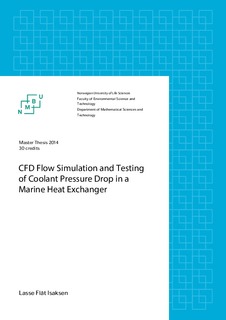| dc.description.abstract | As the focus on energy consumption increase, so does the use of heat exchangers. Utilizing natural temperature differences, is a safe and efficient way to cool fluid medium. Through collaboration in a previous course, Sperre Coolers introduced me to the Rack Cooler, as a new, efficient and stable alternative for engine cooling in the maritime industry. In their process of calculating its total efficiency they were very interested in the pressure drop of the internal coolant through their heat exchanger, and methods of determining it. The method questioned is Computational Fluid Dynamic (CFD) analysis. Since the Rack Cooler is available in a large number of different configurations, three main sizes were selected by Sperre, on request. Each of these three main sizes is in turn available in three different heights, and two different flow patterns, which makes a total of 18 specific configurations.
First we performed experimental testing of pressure drop, in Sperre’s own test facility. Because of reading error in instruments used and a system whose specifications did not match the needs for the testing, these results ended up with a broad spectrum. Still, the results are compared to the CFD results, with various degrees of success.
The CFD analyses were done in SolidWorks Flow Simulation, with 3D-models mostly converted from Inventor. Through simplifications of the 3D-model and a long phase of mesh optimization, a final mesh was set for the rack with the highest number of pipes. Through comparisons of simulating one single pipe in different heights, and simulations of two similar racks, with only difference in height, eight (8) was found as correlation factor. This factor was used to find the pressure drop of the racks higher than those simulated in their fully extend. In an attempt to further refine the mesh, a smaller rack then the optimization was done on, was used. This resulted in a much lower pressure drop simulated in the same rack. This initiated an investigation why, and the result show clearly a mesh which is too coarse for these simulations. The most unambiguously result, which is supported both of the testing and all the simulations, is that the pressure drop in a 2-pass configuration is more or less half of the pressure drop in a 4-pass configuration. The conclusion states that the need of computer power (due to the need of further mesh refinement) far exceeds what was available at the time of the work on this thesis.
Further development of the test facility and improved computer capacity is required for more applicable and accurate results. | nb_NO |
